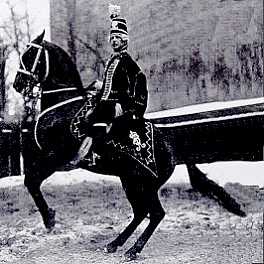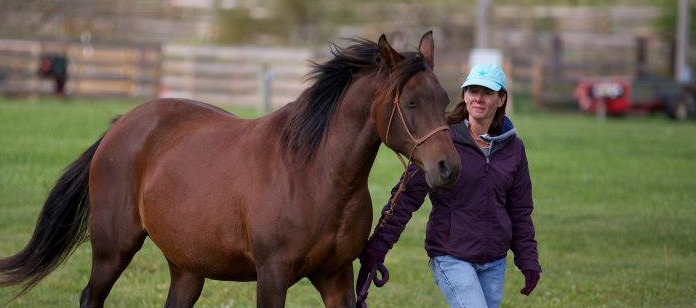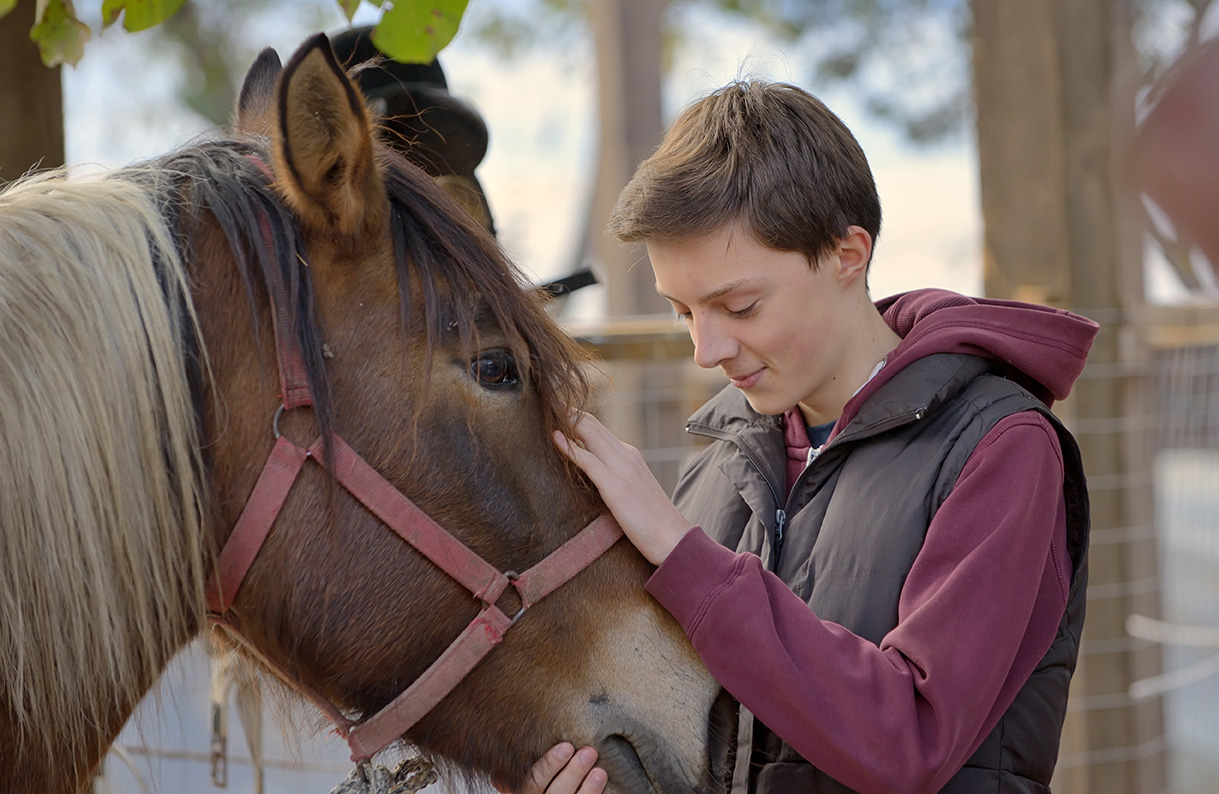The Biped’s Dilemma & The Rider’s Role in Keeping the Horse Sound

The Missing Piece in the Lameness Puzzle
During my equine bodywork practice, I occasionally encounter horses with unexplained lameness or “offness”. Vet, farrier and saddle fitter have exhausted their possibilities and the owner faces their horse’s recurring unsoundness without explanation. Here, bodywork provides relief and can sometimes solve the problem “accidentally” (by releasing deep-seated tension) without knowing the cause.
More often, however, there is a missing piece in the puzzle: the horse/rider interaction or rider biomechanics and how the rider affects the horse’s soundness.
The Horse as a Riding Animal – 2 Undeniable Facts
- Our vertical spine meets the horse’s horizontal spine in various levels of impact during a sequence of motions of two separate yet attached bodies and
- “There is nothing natural about horse back riding”, since horses were not by nature designed to carry a rider.
To Keep a Horse Sound – 2 Inconvenient Conclusions
- Yes, riding a horse implies the possibility of doing the animal harm, simply based on the biomechanical parameters and
- Riding technique is a factor that can keep the horse sound or potentially make him unsound.
Rider biomechanics have been on my mind for a long time, since I am interested in anything that can improve the horse’s soundness.
This is a vast topic and I can only highlight a few aspects and hope to enthuse you for the subject.
Riding Technique & Ability

A riding lesson on the longe line is a great way to practice an independent seat
When we talk about and want to address rider biomechanics, we need to differentiate between
- natural inclinations rooted in our being human (biped),
- ability (flexibility and strength) and
- technique (did we learn how to sit, how to ride right?).
We need to recognize our natural inclinations, hone our abilities by tuning our bodies, and perfect our technique by getting correct instruction and putting into practice.
The Biped’s Dilemma
As bipeds (beings that move upright on two feet) we often naturally move contrary to the horse’s quadruped movement. As riders, our dilemma is that what we want to do naturally – humans love to ‘push, pull, and dig in their heels’ – goes against “riding right” or staying out of the horse’s way. It is not natural to us. We – our minds and bodies – need to learn that.
As an example: The walk, the ‘easiest’ of all gaits to ride. We bipeds move our arms diagonally to the legs during the walk, meaning when our right hip moves forward, our right arm moves back. When we ride and hold the reins, we will tend to do the same: move the right hip forward, and the right arm back (even if ever so slightly). Try it on a chair! This directly counteracts the movement of the horse and means, that if we do not want to jar the horse’s mouth with every step, we need to make a conscious effort to develop an independent seat, where hip can move independently of arm.
The Slow Dismantling of “Thunder” – A Fictional Case Study
“Jane” – who has not yet developed an independent seat – rides her new horse “Thunder” – a willing and compliant horse – for several months, jarring his mouth with every step in the walk. Soon the horse develops a ‘dead mouth’, responses to rein aids get duller and duller, leading the rider to conclude the horse needs a sharper bit, especially since Thunder started rushing under saddle.
After using the sharper bit for some time – which works wonders with the ‘stoppability’ – the horse starts shortening the stride and refuses to take the right lead. He develops an unwillingness to bend in the neck and an ornery temperament. Jane and her trainer attribute this to a number of factors unrelated to Jane’s rider biomechanics and Jane continues to ride until the horse develops unexplained front leg lameness. A journey through farriers and vets begins with no result.
This is a fictitious scenario, a combination of different cases I’ve experienced.
Similarities to real, living horses are merely coincidental ;-).
Discomfort, Compensation & Self-Preservation
What happened here?
- Jane caused the horse discomfort in the mouth by moving like a biped on the back of this quadruped.
- The horse started carrying himself in a way that compensates and allows him to avoid the discomfort as much as possible.
- A whole series of self-preservation mechanisms ensue that make it difficult to understand, where the original problem lies:
How Jane & Thunder Got Here
- Instead of swinging his head and neck lightly up and down during the walk, he will hold his head still, and his neck stiff, in anticipation of the next jarring feeling in the jaw.
- Over time, the ‘head neck muscle’ (bracchiocephalicus) and related muscles become permanently contracted. This muscle’s job is to move the front leg forward. Through the restriction, the horse’s stride becomes shortened.
- Soon the tension will expand into the upper neck musculature and muscles that are responsible for the movement of the shoulder blade (scapula). The shoulder becomes tight and unyielding.
- Since the shoulder is the ‘shock absorber’ for the front legs, it now loses its function as such and the front legs have to bear most of the impact with every step. The trot becomes choppy, the strides restricted.
- Discomfort and restriction leads the horse to get stiff in the neck and possibly refuse to take one lead or another.
By the time the symptoms become loud, this has been going on for a while.
Could Your Riding Be a Factor in Your Horse’s Soundness?
Often it’s hard to make the connection. It’s not easy to ask yourself ‘how could my riding be a factor’? Nevertheless, it’s the right question to ask. The answer is always YES! For all of us, even master riders!
3 Steps Toward Better Riding
- Understand your “biped” nature and natural inclinations! Understand how the horse moves and what it needs!
There is an excellent website with in depth information regarding rider biomechanics here. You can also order a book on this website about the same topic. - Improve your “riding ability”, meaning flexibility and strength in the right places. Read my separate article about “The Able Rider”, improve your flexibility with daily exercise and get strong but not buffed! Yoga, Pilates, Pavel Tsatsouline’s “Strong First” and “Relax into Stretch” are great resources!
- Study Riding Technique with a qualified instructor and get longe lessons to improve your seat. Caution: Incorrect instruction (unfortunately more the norm than the exception) does more harm than good. Brush up on your knowledge of classical horsemanship before committing to an instructor.
Do Little – Reap a Lot!
Even small changes in your riding can make a big difference for your horse’s soundness.
As a non-ambitious rider who doesn’t show, I have to make a conscious effort and work on my seat. Having seen quite a bit of damage to horses by unskilled (often very experienced!) riders, I am painfully aware of what my riding can do to my horse and do what I can to get guidance and feedback, to keep myself flexible and strong, so I can work on my independent seat and stay out of my horse’s way.
I hope you find this article helpful and you now feel enthused to explore the topic in more detail!
Have a harmonious ride and enjoy your horse!

If you have a story to share or tips or experiences regarding Biomechanics of Riding, please email me stef@reinholdshorsewellness.com or share your comment.
You may also like: “The Rider’s Back Muscles Part 1“





Stefanie,
I hear you! It pains me to see how a light rider can be so punishing with the seat while some heavy riders seem be able to be gentle with their feel for the horse (surprised me a good deal last year to see one I thought would be a tough carry for her small horse get giddy to leap jump obstacles easily once she mounted and showed a lightness and connection in the saddle).
One of the things I discovered (with twenty years of galloping race horses – some in very short stirrups) is the seat is key – along with being able to operate all your other body parts on a horse independantly. Seems kind of paradoxical, I imagine, since ideally, most time on racehorses is spent out of the saddle, but the fact is, there are times when explosions occur that you want to be connected with the horse subliminally – and if you don’t have a subconsious connection to the horse in such situations through your seat (particularly in situations where your stirrups are so short there’s no shot at using your legs for traction), you’re going to be buying some real estate. It’s kind of a light bulb moment when you finally realize your seat is so connected with the horse, no matter what they do, you are glued to the saddle through relaxation. This is a wonderful moment I hope all your readers (and any other equestrian) are able to realize in their lifetime.